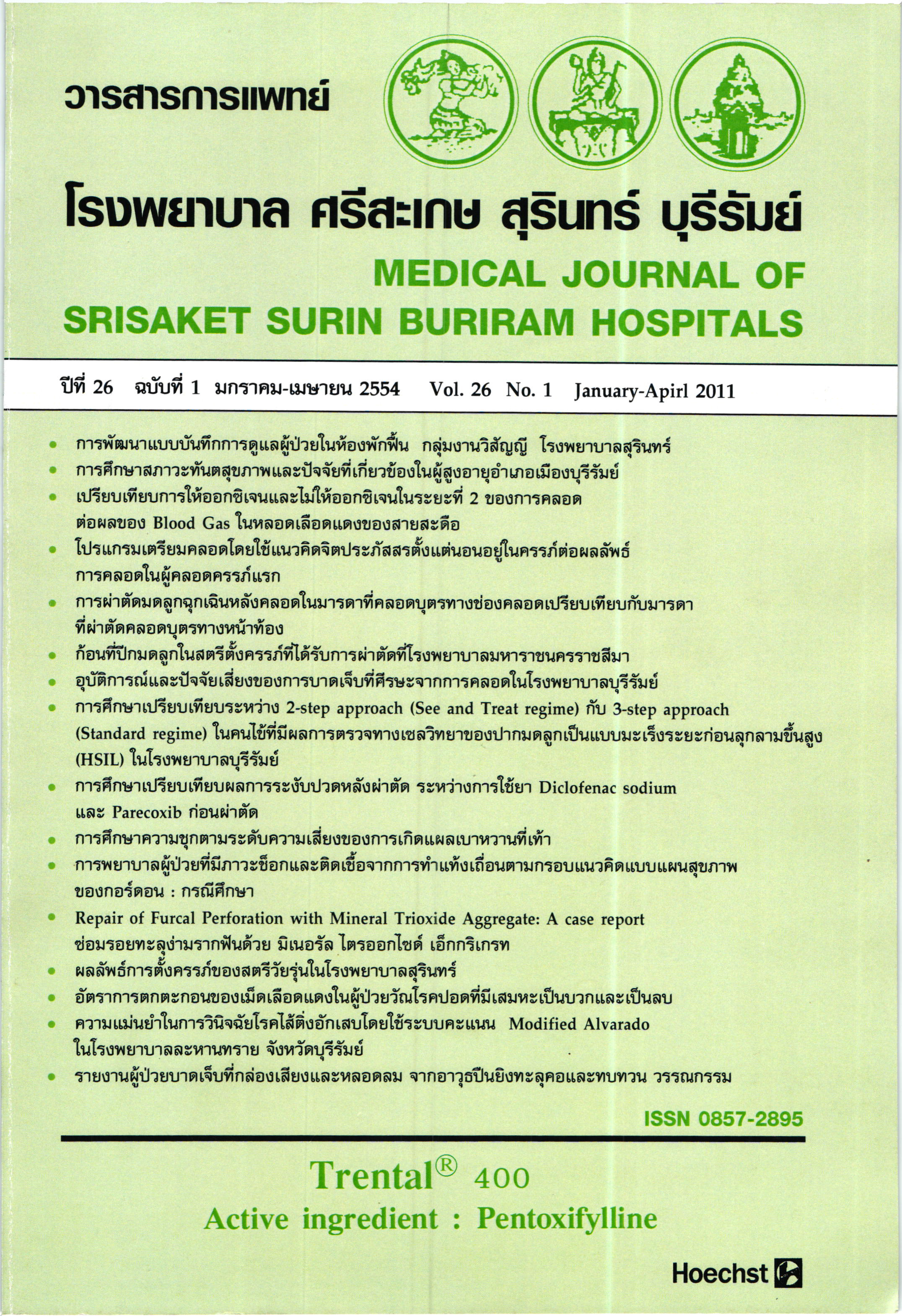การศึกษาความชุกตามระดับความเสี่ยงของการเกิดแผลเบาหวานที่เท้า
Main Article Content
บทคัดย่อ
วัตถุประสงค์: เพื่อศึกษาความชุกของผู้ป่วยเบาหวานที่มีความเสี่ยงต่อการเกิดแผลที่เท้าในระดับต่างๆ ตาม The University of Texas Diabetic Foot Classification System (UTDFC)
รูปแบบการวิจัย: การวิจัยเชิงพรรณนาที่เวลาใดเวลาหนึ่ง
สถานที่ทำการวิจัย: คลินิกเบาหวาน โรงพยาบาลศรีสะเกษ
กลุ่มประชากร: ผู้ป่วยเบาหวาน 424 คน
วิธีการศึกษา: ผู้ป่วยเบาหวานที่มารับบริการที่คลินิกเบาหวาน เดือนมีนาคม - กันยายน 2553 จำนวน 424 คน ประเมินสภาพเท้า ตรวจ protective sensation ด้วยโมโนฟิลาเมนท์น้ำหนักกด 10กรัม และจัดระดับความเสี่ยงของการเกิดแผลที่เท้า
ผลการศึกษา: ผู้ป่วยเบาหวาน จำนวน 424 คน ส่วนใหญ่เป็นหญิง 280 (ร้อยละ 66) ช่วงอายุเฉลี่ย 58.2 ปี ผู้ที่เสีย protective sensation 75 คน (ร้อยละ 17.7) มีความผิดปกติของเส้นเลือด 3 คน (ร้อยละ 0.7) เมื่อจัดระดับของการเกิดแผลที่เท้าตาม UTDFC พบความเสี่ยงระดับ 0 (ยังไม่มีพยาธิสภาพที่เท้า) จำนวน 204 คน ระดับ 1 (เสีย protective sensation) จำนวน 75 คน ระดับ 2 (เสีย protective sensation และเท้าผิดรูป) จำนวน 22 คน ระดับ 6 (มีความผิดปกติของเส้นเลือดที่เท้า) จำนวน 3 คน
สรุป: แม้ผู้ป่วยเบาหวานที่คลินิกเบาหวานส่วนใหญ่ยังไม่มีพยาธิสภาพที่เท้า แต่ร้อยละ 51.9 ของผู้ป่วยเบาหวานมีความเสี่ยงในการเกิดแผลที่เท้าแล้ว ดังนั้นผู้ป่วยเบาหวานทุกคนควรได้รับคำแนะนำในการดูและเท้าอย่างถูกวิธี และส่งต่อผู้ป่วยที่มีความผิดปกติไปพบแพทย์ผู้เชี่ยวชาญต่อไป
Article Details
เอกสารอ้างอิง
Thai Multicenter Research Group on Diabetes Mellitus. Vascular complications in non-insulin dependent diabetics in Thailand. Diabetes Res Clin Pract 1994;25:61-9
Aekplakorn W, Stolk RP, Neal B, Suriya-wongpaisal P, Chongsuvivatwong V, Cheepudomwit S, et al. The prevalence and management of diabetes in Thai adults: the international collaborative study of cardiovascular disease in Asia. Diabetes Care 2003;26:2758-63.
Fryberg RG. Team approach toward lower extremity amputation prevention in diabetes. J Amer Ped Assoc. 1997; 87: 305-12.
Moss SE, Klein R, Klein BED. The prevalence and incidence of lower extremities amputation in a diabetic population. Arch Intern Med 1992;152:610-6.
Pecoraro RE, Reiber GE, Burgess EM. Pathways to diabetic limb amputation: basis for prevention. Diabetes Care 1990;13: 513-52.
Center for Disease Control and Prevention. History of foot ulcer among persons with diabetes: United States 2000-2002. MMWR Morb Mortal Wkly 2003; Rep 52:1098- 102.
Reiber GE, Boyko EJ, Smith DG. Lower extremity foot ulcers and amputations in diabetes. เท: Diabetes in America. 2nd ed. Bethesda: National Institutes of Health, 1995:409-28.
Vichayanrat A, Lueseangdang L, Pitmana- aree S, et al. Diabetic foot ulcer. Siriraj Hosp Gaz 1979;31:883-97.
Sriussadaporn A, Mekanandha P, Vanna- saeng S, Nitiyanant W, Komoltri C, Ploybut S, et al. Factors associated with diabetic foot ulceration in Thailand: a case-control study. Diabet Med 1997; 14:50-6.
Center for Disease Control and Prevention: Diabetes Surveillance 1993. Atlanta, GA: US. Department of Health and Human Services, 1993.
วิลาวัณย์ ถิรภัทรพงศ์, กุลภา ศรีสวัสดิ์, นวพร ชัชวาลพาณิชย์. การศึกษาระบาดวิทยาและค่าใช้จ่ายในการรักษาผู้ถูกตัดเท้าหรือขาเนื่องจากเบาหวานที่โรงพยาบาลศิริราช (รอการตีพิมพ์)
Armstrong DG, Lavery LA, Harkless LB. Treatment based classification system for assessment and care of diabetic feet. J Am Podiatr Med Assoc 1996; 86:311-6
.
Edgar J.G. Peters, Lawrence A. Lavery. Effectiveness of the diabetic foot risk classification system of the international working group on the diabetic foot. Diabetic care 2001;24:1442-7.
Birke JA, Sims DS. Plantar sensory threshold in the ulcerative foot. Lepr Rev 1986;57:261-7.
Kumar S, Fernado DJ, et a I. Semmes-Weinstein monofilaments: A simple, effective and inexpensive screening device for identifying diabetic patients at risk of ulceration. Diabetic Res Clin Pract 1991;13:63-7.
Golueke Pj Fau - Goldstein, A.S., et al. Routine versus selective exploration of penetrating neck injuries: a random ized prospective study. J Trauma 1984; 24(12): p. 1010-4.
Meinke AH, B.B., Sachatello CR, Selec tive management of gunshot wounds to the neck. Report of a series and review of the literature. Am J Surg 1979; 138(2): p. 314-9.
Bagheri Sc Fau - Khan, H.A., R.B. Khan Ha Fau - Bell, and R.B. Bell. Penetrating neck injuries. Oral Maxillofac Surg Clin North Am 2008; 20(3): p. 393-414.
Noyes Ld Fau - McSwain, N.E., Jr., I.P. McSwain Ne Jr Fau - Markowitz, and I.P. Markowitz; Panendoscopy with arteriog raphy versus mandatory exploration of penetrating wounds of the neck. Ann Surg 1986; 204(1): p. 21-31.
Munera F Fau - Cohn, S., L.A. Cohn S Fau - Rivas, and L.A. Rivas. Penetrating injuries of the neck: use of helical com puted tomographic angiography. J Trau ma 2005; 58(2): p. 413-8.
Flynn Ae Fau - Thomas, A.N., W.P. Thomas An Fau - Schecter, and W.P. Schecter; Acute tracheobronchial injury. J Trauma 1989; 29(10): p.1326-30.
Mussi A Fau - Ambrogi, M.C., et al. Acute major airway injuries: clinical features and management. Eur J Cardiothorac Surg 2001; 20(1): p. 51-2.
Karmy-Jones R Fau - Wood, D.E. and D.E. Wood. Traumatic injury to the trachea and bronchus. Thorac Surg Clin 2007; 17(1): p. 35-46.
Angood Pb Fau - Attia, E.L., et al. Extrinsic civilian trauma to the larynx and cervical trachea-important predictors of long-term morbidity. J Trauma 1986; 26(10): p. 869-73.
Akhtar S, A.S. Laryngotracheal trauma: its management and sequelae. J Pak Med Assoc 2008; 58(5): p. 241-3.
Ngakane H, M.D., Luvuno FM. Penetrat ing visceral injuries of the neck: results of a conservative management policy. Br J Surg 1990; 77(8): p. 908-10.


